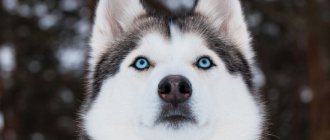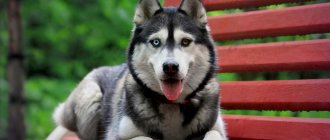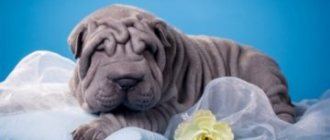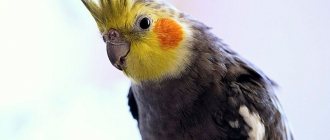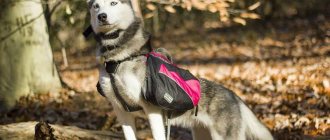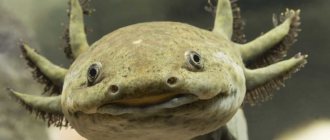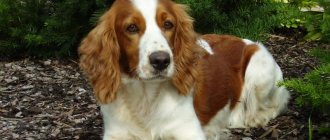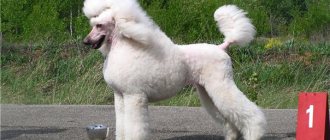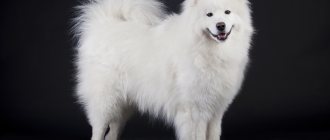The Siberian Husky breed has gained popularity all over the world due to its unusual bright appearance, active and good-natured disposition.
If you decide to buy yourself a puppy of this breed, do not hesitate - you will not just buy a dog, but a friend for life.
Description of the breed
The ancestors of the Husky are sled dogs originally from Chukotka. One of the peoples who kept “shaggy horses” were the Eskimos. English sailors from merchant ships who visited those parts pronounced the name of the nationality as “huskimos”. Hence the name of the dogs.
In the mid-nineteenth century, the hardy dogs were brought to Alaska, where they were crossed with local breeds. The result was a medium-sized dog with a harmonious build, thick hair and a fluffy tail curled up. According to the breed standard, recorded in the 30s of the twentieth century, a husky must have:
- triangular erect ears;
- muzzle tapering towards the nose;
- strong short-haired limbs;
- almond-shaped eyes of brown or blue (multi-colored eyes are allowed);
- scissor bite;
- straight back with well-developed lower back;
- wide chest.
Huskies include:
- Siberian variety (height up to 60 cm, weight up to 28 kg);
- Alaskan Malamute (up to 65 cm, up to 45 kg);
- Klee Kai (up to 42 cm, up to 10 kg);
- Akita Inu (up to 67 cm, up to 50 kg);
- Samoyed (up to 57 cm, up to 30 kg).
The length of the coat depends on the type of husky and its pedigree. Purebred Siberians and Malamutes are classified as shorthaired. The standard does not recognize long-haired beauties, however, as a pet (not a show dog), furry strongmen are very popular.
What is the difference between a husky and a malamute?
The breeds have a lot in common. Both types have similar physical characteristics and levels of endurance.
Huskies come from Siberia, Malamutes are representatives of Alaska. They were bred for sled racing, they know how to hunt, but they will not give the prey to the owner.
Interesting article: Alaskan Malamute: characteristics and description of the breed
Table of differences:
| Husky | Malamutes |
| Develop high speed. Can quickly deliver cargo that is not too heavy | Physically stronger, more resilient, but slower |
| Temperamental, cunning | Calm, positive attitude |
| They love children. They will play with them and become good nannies | Indifferent to kids. Avoid noisy guys |
| Do not demonstrate groundless aggression towards humans or animals | They consider only the owner. Other people are ignored |
| They have a loud, hoarse voice | Silent people. They bark in extreme cases |
| More compact in size | Larger, 10-12 kg heavier |
| They have an excellent appetite, some individuals are prone to overeating | They know when to eat in moderation |
| Height at withers – 51-60 cm | 58-70 cm |
| Have double hair | Rough, sticky fur |
| Wide variety of coat colors | The list of color options is limited to: gray, charcoal, sable, chocolate-white. There is a color mask on the face |
| Pure blue eyes are a unique feature. Other iris colors are less common | Brown with black edging |
| The tail is curled into a ring and lowered | Not particularly curled, pointing upwards |
Many dog breeders have tried to cross the Malamute with the Husky. The result is stately dogs that have inherited the character of the representatives of Alaska, outwardly repeating the Siberian individuals. Despite the beauty of the puppies, the offspring are considered outbred.
Interesting article: Difference between Siberian Husky and Alaskan Malamute
How to properly care for and raise a husky puppy?
Raising a Husky puppy into an adult, well-trained dog will require patience and endurance. Hasyats need care and constant supervision, like small children. He must understand the purpose of the tray, know his place, remember his nickname and learn to be alone. You will have to endure the dog's hysterics after the owner leaves. You can’t go back and console him, otherwise the “protest rallies” will never end.
Grooming (combing, examining and cleaning ears and teeth) begins as early as possible so that the puppy perceives these procedures as a necessary part of life. The first vaccinations must be given by the breeder. Vaccination documents must be obtained upon purchase. The nursery usually explains which vaccinations need to be done and when.
The puppy must know that the person is in charge, and it is he who sets the rules.
Breeding
Huskies are bred in nurseries. Owners who decide to take on this matter on their own should know that childbirth in a primiparous female is difficult, so it would be a good idea to enlist the help of a veterinarian. Otherwise, you need to be prepared for surprises during birth and to provide assistance to the mother and puppies.
Siberian beauties
Absolutely healthy individuals are selected for mating. Before mating, deworming must be done.
When a husky begins her first heat, her activity increases, and the bitch may show some aggressiveness. It is necessary to examine the external genitalia daily. The loop increases in size and bleeding appears.
The day of hunting is determined for each bitch individually. The generally accepted scheme: 9th or 11th day, does not always work. While stroking the female's hips, press on the lower back, closer to the croup. If the dog is tense, stands motionless, moves its tail to the side or up - it is ready for mating.
Tips for caring for a puppy
When caring for hasyats, you should pay attention to:
- Grooming will bring less worry to both the owner and the pet if you start it from the very first day.
- Ears are the weak point of the Siberian beauty. They are inspected and cleaned a couple of times a week.
- The soft baby fluff is combed out very carefully, with a special brush, 1-2 times a week. After a year you need to comb it every other day.
- They bathe the Khasenysh as rarely as possible. Regular brushing is enough to get rid of dust and dirt. Bathing with shampoo (special, not “human”) is necessary approximately once a year.
- The puppy's nails are trimmed very carefully so as not to damage the skin. If the dog often runs on hard surfaces, then the nails do not need to be cut; they grind down on their own.
- It is necessary to regularly check your dog for fleas, ticks and other parasites.
If you have no experience caring for puppies, you should seek advice from a veterinarian. A specialist will tell you how to make care safe and comfortable.
Accustoming to home environment
To the question: “Is it possible to keep a husky in an apartment?” - the answer will be in the affirmative, but an aviary would still be better for keeping.
Caring for a Husky puppy will require a lot of time and patience. In the first month of life in a new place, the pet requires maximum attention from the owner. The puppy should be left alone as little as possible. To protect the home from the animal’s vigorous activity during their absence, owners often arrange spacious cages in the apartment. A rug and toys are placed inside.
Important! In the process of raising a puppy, he must learn the ban on everything that will not be allowed in the future to an adult dog!
Care should be taken to ensure that the pupil does not have access to storage areas for household chemicals, building materials, plant treatment products, and poisons. Wires of electrical appliances should be kept out of the puppy's field of vision. It is recommended to remove valuable and fragile items, shoes, carpets, and outdoor flower pots.
Family
Some recommendations on how to raise a Husky at home in order to raise a smart, loyal, obedient dog are presented below:
- The owner is the boss in everything. Only he sets the rules of behavior, and none of the household members can change them.
- For good behavior – reward. Encourage your pet with treats and voice immediately after doing the right thing. Punishment is applied in the following cases:
- Aggression towards the owner.
- Performing actions that are dangerous for the dog itself.
- Aggression towards relatives.
- Unquestioningly follow the commands : “Come to me!”, “Nearby!”, “Sit!”, “Look!”, “Place!”.
- Coordinate behavior, offer an alternative: “Take this, but not that!”
- Avoid violence and physical punishment. In a clear, firm, calm voice, pronounce prohibitory commands: “Stop!”, “You can’t!” As punishment, the puppy is taken by the withers and pressed to the floor, not allowing him to move. They release him when he gives up resistance and relaxes.
What does a husky puppy need?
Before a charming baby appears in the house, you need to take care of many things:
- house or bed;
- tray;
- diapers;
- toys;
- collar, leash;
- bowls;
- care products (brushes, combs, shampoo);
- special toothbrush and toothpaste.
Separate bowls are needed for food and water. It is better to choose stainless steel containers with a stable design. The puppy will quickly learn to turn plastic bowls over and will definitely try to chew them.
What is required for maintenance
- Bowls made of food grade stainless steel.
- Toys – balls, ropes and special bones.
- Toilet diapers . They will make it easier to get used to the tray and will be useful for transportation.
- Bed or sleeping mat . The dog should have his own place
- Comb and brush for combing.
- Leather collar . Metal ones cut off hair in the neck area.
- Leashes . They should be of different lengths or one with a lock. Husky is a sled dog and you can train it to carry you on a skateboard, roller skate or bicycle.
- Shampoo . Wash your dog whenever it gets dirty, but not more than once a month.
Personal place for husky
A house or bed is a zone of comfort and safety. Here Khasenysh feels protected. The baby's personal space should not be too big or small. The dog must stand, lie, and turn freely in it. There are sliding structures that can be expanded as your pet grows.
A soft blanket or pillow made of safe materials is placed inside the house (the baby will definitely try them out). The litter needs to be looked after: cleaned or washed. This is worth remembering when choosing material.
The bed is installed in a quiet place, away from drafts, equipment or noise sources. However, it is impossible to isolate a Khasenysh: the dog must be able to see what is happening, observe the owner and family members. Otherwise he will feel lonely.
The first acquaintance with a personal place will be easier if you put several toys on the bed. You need to choose objects that are large enough and smooth enough so that the puppy does not swallow them or get hurt. The baby is brought to the bed, slightly pushed and pronounced “Place.”
An adult husky cannot live in a house, with the exception of specially bred “apartment” species (Klee Kai, American Eskimo). The dog needs a spacious enclosure or booth.
You cannot use your puppy's personal space for punishment.
Disadvantages of the breed that appear when living in an apartment
The breed is quite large, adult dogs reach 63 centimeters at the withers, so the breed cannot be kept in a cramped small apartment. A spacious two-room, or better yet, a three-room apartment is suitable. Moreover, the dog should move freely between rooms; in cramped conditions, the husky becomes sad and may develop the habit of howling. Yes, you won’t get your pet to bark, but howl like a frozen wolf - please.
Keeping a husky in an apartment as a guard will also not work; the dog would rather knock a stranger off his feet and happily sniff him, but he won’t be able to scare him away by barking, it’s simply not in his nature.
Curiosity is not a vice - so says the proverb, but not in the case of huskies. In the apartment, all wires should be hidden in the baseboards; no things that resemble toys should be within the pet’s reach. Children's plush toys will most likely be torn apart, because it will be vital for the dog to find out what is rustling inside, much less squeaking or talking.
Sofas and pillows are also at risk - the breed’s love for digging snow is rooted in centuries of selection, the dog may even simply decide to get comfortable without pursuing malicious intent. The problem can be partially solved by having a large number of the dog’s personal toys, while their “staff” must be constantly replenished.
Huskies are used to living in a pack, or rather with their team mates, so it is advisable to have a husky in an apartment if there is someone at home during the day. Prolonged loneliness cannot be replaced even by long walks, and it doesn’t matter to the dog whether they play with him or not, he needs company even for sleep and naps.
Huskies take time, a lot of time. This is due to the walking regime, the need to constantly educate the dog, and the fact that the breed is simply very dependent on having someone nearby.
Features of keeping and caring for an adult husky dog
If a husky lives in a city apartment, he needs to walk at least 1.5-2 hours a day. Moreover, the walk should be active. In a private home, the pet gets more freedom, but it is still necessary to walk with it. Adult huskies are fed once a day, but puppies up to a year old will have to be fed several times a day.
Teeth care and brushing
There is usually no need to care for the teeth of a healthy husky with good heredity. Plaque can form from dietary errors. If this happens, you need to regularly brush your teeth with a special brush and toothpaste.
Ear and eye care
The eyes and ears are examined regularly. Curious dogs often dig through piles of leaves, grass, or debris. Dirt or foreign particles may get into your eyes and ears. After walks, it is advisable to check the pet’s condition and, if necessary, rinse with a cotton pad or soft cloth. Usually clean water is enough, but you can care for it with chamomile decoction or strong tea.
Nail care, when to cut them
If the dog spends a lot of time outside and often runs on hard surfaces (asphalt, concrete, stone), the claws wear down on their own. Nails need to be trimmed when they begin to curl down. They cut it very carefully, millimeter by millimeter, so as not to harm the dog. It is safer to consult a veterinarian for this.
Hygiene procedures, hair care
Constant brushing not only keeps the coat clean, but also has a positive effect on the skin. Movements with the comb and brush massage the body, causing a slight rush of blood. The sooner you start combing, the easier it is.
The first time should be bathed after the baby has completely settled into the house. This may be stressful for him. Khasenysh plunges into water for the first time and panics. You should not bathe your Husky more than once a year. The exception is dogs with a white coat. But here, too, caution is needed - shampoos and water dry out the skin and deprive the coat of its protective properties.
Walking outside
The Khasenysh is taken outside for the first time after the quarantine ends after the second vaccination. You need to walk your pet for at least forty minutes twice a day. The more physical activity and new experiences the dog gets, the less destruction he will cause at home. In winter there are no problems with walks, but in summer you should choose shady, cool places or take your pet out early in the morning and very late when the heat subsides.
Sports equipment: sled, sled, sledge, harness
Features of a riding harness for a husky: the design of such a harness should not restrict the dog’s movements or cause discomfort, otherwise it simply will not be able to carry you .
Such a harness should be well fixed and distribute the weight of the load evenly throughout the body. The straps should be wide and the fastenings strong. Sleds for sledding are sold in specialized stores, and it is still advisable to purchase them there so as not to harm the animal. They are about 80 centimeters wide, and the length directly depends on the number of dogs in the sled. The main rule when choosing a sled is its stability and reliability. Protect both yourself and your dogs.
The sledges themselves are a slightly simplified version of the sleigh, since they are created only for transporting a person, without load. They are much lighter than a sled and will be much easier for the dog to pull. You can often find lightweight aluminum sleds, which due to their design will make traction even easier. However, the choice is yours - wooden sleds are still more reliable.
The harness for your dogs should also be of good quality in order to evenly distribute the load between all parts of the harness. The fastenings that secure each dog in its place must be very strong so as not to accidentally lose a single animal or knock the sleigh or sled off course. Therefore, before choosing riding equipment, consult with those who are already actively using this sport.
Relationships with household members
How does a husky get along with children? Wonderful! This dog is just for those who are not afraid to leave them alone with children. She will happily play with the kids and will not bite. Therefore, this breed is an excellent choice for families.
In turn, a dog will get along with cats if it grew up with them. Otherwise, the cat runs the risk of becoming for the dog an object of irrepressible curiosity and games that the cat itself is unlikely to like.
A newborn child, as in the case of older children, will not be offended by a dog. This is not an aggressive breed at all, so don’t worry if you are planning to have a baby in the family - your pet will not harm him.
Where should you keep your dog?
It is hot in a city apartment for a Siberian, and the fur and skin suffer from the high temperature and dry air. And the owners will have a hard time: wool will be everywhere, especially during the molting period. Huskies usually shed once a year, but in unfavorable conditions they can shed year-round. Only small species are suitable for an apartment; they are much easier to care for.
The best “home” for an active large dog is a spacious enclosure or kennel in the garden of a private house. To set up an enclosure you will need a chain-link mesh made of wire no thinner than 5 mm, preferably stainless steel. You cannot paint the fence so that the dog does not get poisoned (he will definitely try to bite the barrier).
Huskies love earthworks. They make tunnels with incredible speed and strive to escape at the first opportunity. Therefore, the mesh must be installed in the floor or foundation. The floor can be earthen or paving slabs. A canopy from rain and sun is a must. It is important that the enclosure is well ventilated. One, maximum two walls can be blank, the rest can be made of mesh.
Hygiene
Caring for a puppy and an adult husky is quite simple - a minimum of hygiene procedures is required.
Care is based on general recommendations for keeping pets: periodic bathing, combing, cleaning ears and teeth. The only period that causes inconvenience in the apartment is molting.
Bathing puppies and adult dogs
You should not bathe a puppy or an adult husky unless necessary, because when kept in an apartment, pets do not get dirty so often. They are able to take care of their fur coat themselves, and their fur is capable of self-cleaning. Hygienic care is needed only after a walk - washing the paws and wiping the fur with a damp towel.
The minimum age at which bathing will not cause harm is 3 months. By this time, the puppy has developed a fairly strong immune system.
After washing, the pet is dried with a towel and left in the apartment until completely dry. If he is not afraid of noise, it is advisable to use a hairdryer so that no moisture remains in the undercoat.
For your information. In winter, huskies bathe on their own, lying around in the snow - they do not need additional care.
Wool
Caring for Husky fur in an apartment consists of combing at least 2 times a week with a wide-tooth comb or a furminator, which removes dead undercoat without damaging living hairs.
Huskies shed profusely, which causes a lot of trouble when kept in an apartment. During the molting period, animals are combed daily.
In areas where the change of seasons is weakly expressed, the process usually goes unnoticed, since the pet does not grow a thick undercoat.
Important. Some dog breeders are too lazy to care for huskies and cut their fur. This cannot be done - natural heat exchange is disrupted, which is why the dog can become hypothermic or overheated.
Eyes
Eye care is reduced to wiping once a week with a solution of chlorhexidine or chamomile decoction. After field trips, they are inspected for dust and damage.
If redness or excessive tearing occurs, the husky is immediately taken to the veterinarian - a specialist will tell you what kind of care they need.
For your information. The breed is prone to ophthalmic diseases. If you take proper care of your eyes, the risk will be minimized.
Teeth
Huskies that eat dry food clean their teeth of plaque when they chew hard kibble.
With a natural diet, the owner must care for them independently using veterinary paste and a toothbrush. The procedure is carried out 1-2 times a week.
On a note. To prevent tartar, huskies are periodically given brain bones or dental treats to chew on.
Ears
The owner should take regular care of the ears - inspect them approximately once a week. If sulfur and dust have accumulated, wipe them with a cotton pad soaked in a solution of hydrogen peroxide or chlorhexidine.
The onset of the inflammatory process is indicated by itching and frequent shaking of the head. In this case, the husky is taken to the veterinarian - the doctor will prescribe special drops for caring for the ears.
Claws
Active huskies usually wear down their claws by running on asphalt and other hard surfaces, so they do not require additional care. If the dog moves only on the ground and soft floor in the apartment, the claws are shortened once a month using a nail clipper.
For your information. For hygienic purposes, the hair between the paw pads is also trimmed to avoid dirt accumulation. It provides protection from frost, but when kept in an apartment, the pet is not exposed to the cold for many hours in a row.
Care and maintenance of the Siberian Husky
Keeping a pet consists of feeding, walking, playing and training, grooming and regular visits to the veterinarian. You cannot raise a Khasenysh in isolation. If he does not learn “from the very beginning” to communicate with other animals, not to be afraid of city noise and large crowds of people, serious mental problems may arise in the future.
At home
Caring for a husky in a private house or apartment is no different. The only difference is the comfort of the dog and the owner. For urban conditions, small subspecies of the breed are chosen, and large dogs can be kept on a personal plot.
In a private house
Being outside (in an enclosure or kennel) is an important condition for keeping frost-resistant huskies. The dog is much more comfortable in his own home; he can run freely around the entire area. The only thing you have to keep an eye on is the condition of the fence. If the fence around the territory is poorly reinforced or not buried in the ground, the husky will dig under the ground and break free.
Husky attitude towards children
The Siberian Husky is one of the few popular dog breeds among domestic breeders, which is characterized by the absence of aggression towards humans at the genetic level. This feature applies to huskies, regardless of age, so the owner can be completely calm about the life and health of both guests and all their household members, including even very young children.
Important! The Siberian Husky is able to get along well with people, and will become not only an excellent playmate for older children, but also a very devoted and faithful nanny who takes care of little ones.
The only problem when keeping a dog at home in families with children may be the rather large size of an adult dog and its increased activity . If such a pet has not received a decent upbringing and has not completed a general training course, then it is quite possible that during the game the dog will accidentally knock the baby down. It is for this reason that experts and experienced husky owners recommend that at first you be sure to monitor the process of communication between your pet and a small child.
Return to content
Is it possible to put it on a chain?
You can't keep a husky on a chain; he doesn't know how to sit in one place. This option is only suitable for guard breeds. The optimal equipment for restraining your pet is a collar, leash and muzzle for walking. Leather or nylon are suitable for the first collar. The length of the leash is 1.5-2 meters. The size of the collar is suitable if two fingers of the owner fit between it and the pet’s neck. Without a collar, a dog can only be released in a fenced area.
Only sports dogs that run many kilometers in a harness per day can be chained.
Where to start settling in for a new tenant?
Until 1-1.5 months, the puppy should not be separated from its mother and other babies. At the same age, the first contact with a person occurs - the beginning of socialization.
In a new family, the puppy should immediately have a clearly defined place to rest and eat. It is better if it is a space away from heating devices and drafts. The owner must prepare a diet, prepare dishes, toys and accessories.
Favorite toys
What to feed a puppy and an adult dog?
When caring for a husky, feeding becomes a stumbling block. If left unchecked, pets eat everything all the time, quickly gain weight, become clumsy and get sick. Puppies are fed 5-6 times a day at first, and after 3-4 months - no more than 4 times. By six months the number of feedings is reduced to 2-3, only two remain per year, and after that the dog will have enough once a day.
Hasyats can be given:
- dairy products;
- meat, fish;
- porridge;
- vegetables.
Raw cartilage, bones, offal and eggs are added to the diet of an adult dog. You cannot feed your pet with leftovers from the owner’s table - human food is too fatty and contains a lot of harmful chemicals (preservatives, dyes, flavoring additives).
Huskies are prohibited:
- pork, lamb;
- smoked, spicy foods;
- butter;
- River fish;
- sweets (all, including the so-called low-fat ones);
- grapes and raisins;
- any canned food, except special dog food.
You can feed with natural products or prepared foods (dry mixtures, canned food). But it is strictly forbidden to mix these two types of feeding.
Natural nutrition
Tasty, healthy, but very troublesome and expensive. Huskies need to be cooked separately; human diet is not suitable for her. Products must be fresh and of high quality. For example, store-bought chicken loaded with preservatives can cause allergies.
Dry food
Simple, fast, but not very useful. And not too cheap. Low-quality food is not suitable for Huskies - they contain many unnecessary and sometimes harmful components. Ready-made food must be premium. With this regime, the pet needs to drink a lot so as not to get dehydrated.
Nutrition
When preparing a diet, you can use natural products and industrial feed. Factory provisions must be premium. Cheap options will not work. In high-quality nutrition, the amount of vitamins and microelements needed by the animal is calculated.
Natural food is preferable for huskies, however, it is difficult to properly balance it.
Huskies are able to digest even fatty meats.
Tips for creating a diet for your pet:
- 70% of the diet should be meat;
- Give boiled zucchini and pumpkin, fresh carrots and cucumbers;
- rice, buckwheat should be included in the daily menu, without salt;
- add grated apples to kefir and cottage cheese;
- mandatory - tripe, chicken kidneys;
- Give boiled sea fish weekly.
This type of nutrition must be enriched with vitamin complexes.
You should not feed your pet before bedtime. Dinner should be offered at least 1 hour before bedtime.
Feeding a Siberian Husky puppy is significantly different from feeding an adult. At 1 month, the baby lives on mother's milk. Later, he is gradually transferred to factory feed or natural products. Industrial granules are soaked in water or in low-fat meat broth.
If you choose homemade food, you should focus on boiled beef, turkey, and sea fish. Steamed vegetables, fresh fruits, cereals, cottage cheese are the basis of the menu.
On high-quality nutrition, the fluffy creature grows quickly, becomes stronger, and develops good immunity. Weight at 4 months will reach 14 kg.
Expert opinion
Anna Abramenko
An avid dog lover. Experience in veterinary medicine since 2009.
Ask a Question
It is forbidden to feed your pet sweets or food from the common table.
The right regime for a husky
Khasenysh sincerely believes that getting up at four in the morning is good. Convincing him that he needs to sleep at least a little longer is difficult. Approximate daily routine (the pet will adjust it anyway):
- getting up at the same time (forget about weekends and holidays);
- immediately after sleep, an active one-hour walk (preferably jogging);
- upon return, wash paws;
- breakfast;
- another exit to the street for natural reasons (15-20 minutes after eating);
- During the day, it is advisable to feed the puppy and play with it (you can invite friends and acquaintances if the owner is at work);
- It is not necessary to feed an adult dog during the day, but it won’t hurt to entertain him (you can leave the radio or TV on);
- in the evening, clean up the mess, wipe up puddles, change the water and feed (the interval between feedings is 8-12 hours);
- about forty minutes after dinner - a long and active walk (can be combined with training);
- before going to bed, another sanitary walk (short and calm).
In general, dogs sleep more than people, but waking their owner at dawn is an almost immutable law. The daily routine should include walks (total duration 2-3 hours), communication with other dogs, games, classes and training.
How long should you walk your husky per day?
Huskies have one more particularly important point in their care and maintenance, namely walking. As already mentioned, you can’t just take your dog outside for 5 minutes to go to the toilet. Active and energetic animals require a special approach.
If the animal is kept in an apartment, then walks should take at least 2 hours a day. This time can be divided into 1 hour in the morning and 1 hour in the evening. If a person is uncomfortable and needs to rush to work in the morning, then in the morning you can limit yourself to a 30-minute jog.
Important! Full physical activity is allowed only after the dog reaches the age of 1 year. By this time, the dog’s skeleton is already fully formed and it can frolic and jump without negative consequences for itself.
Walking the dog is very important
Raising and training a dog
Education begins from the first day the baby appears in the house. Khasenysh is immediately placed in a tray covered with a diaper and is not released (with persuasion, affection, but not force or screaming) until the puppy goes to the toilet. For this, the Khasenysh is sure to be praised and treated. The diaper is not changed so that the characteristic smell remains.
The baby gradually remembers his nickname (a short name is easier to remember), masters basic commands, learns to go to the toilet on the street, and stay close to his owner. From about six months you can start training with a dog handler. Training a dog on your own is not easy. Mistakes and gaps in education will cost you dearly in the future.
Signs of illness in a husky
The puppy should be very active, playing, barking, responding to touch and jumping on its feet. Signs that your dog is sick:
- lies in the corner and shows no signs of presence;
- does not respond to stroking;
- eyes water;
- bloated stomach;
- there is discharge from the ears and nose;
- curvatures in the tail indicate displacement of the vertebrae;
- the dog smells unpleasant;
- bad breath;
- discharge from the anus.
Diseases and vaccinations
With good heredity, the health of a husky is not a cause for concern. True, each subspecies has its own weak points: eyes, ears, diseases of the larynx, problems with the coat. The first vaccinations must be given by the breeder. Further, it is better to entrust the concern about the choice of vaccine and timing of vaccinations to the veterinarian.
Despite their frost resistance, huskies can catch a cold. Their thick coat takes a long time to dry after bathing. You should not let your dog go outside until the fur is completely dry. Another problem is the summer heat. Your pet should always have access to water and it is better to limit its activity for a while.
Most health problems arise from lack of physical activity and obesity.
Peculiar features of the husky's character
Representatives of this breed are endowed with a very unique character. You will need to thoroughly study the pros and cons of a husky and how to keep such a breed before making a final decision in favor of buying such a dog.
Husky howl
You can often hear the question: do huskies bark, the answer to which is: these dogs are not characterized by strong “gibberish.” As a rule, dogs barking can be heard extremely rarely, due to very significant reasons. But with its howling, a pet can seriously spoil the owner’s relations with neighbors. The question of why huskies howl worries many owners.
The cause of howling in most cases is considered to be boredom.
It is unlikely that it will be possible to completely wean an animal from howling, but any owner can reduce the “voice” of a four-legged friend to a minimum. To do this, you need to train your pet, trying to load it as much as possible during the day. An animal that does regular physical exercise: accompanies the owner on walks, while cycling, skiing, rollerblading, will behave more calmly and balanced.
Husky in the company of children
The company of a husky and a baby looks touching. The dog touchingly looks after the child, treats him kindly and tenderly. The problem can be caused by the activity of a large dog that has not been trained in the norms of correct behavior. She is quite capable of knocking a child down while playing. The best option would be for a child to play with a husky, supervised by an adult.
Husky and other animals
Huskies have a well-developed hunting instinct. Neighborhood cats (in extremely rare cases, even decorative fluffy dogs) can become objects of hunting for purebred dogs. The owner is unlikely to be able to completely wean his pet from the habit of chasing cats, but with the help of training, he will be able to correct the animal’s behavior.
Friend, athlete and just handsome
A well-groomed and well-mannered husky is the pride of the owner. To achieve such a result, you need unlimited patience, love and respect for the dog, rigor and discipline. The “technical” side of care usually does not cause problems if true friendship develops between the dog and the person.
Huskies always choose the family member with the strongest character as their leader. At the same time, a completely different person can feed them, care for them, and take them for walks. Dogs intuitively sense a leader. Sometimes owners are puzzled by the choice of pet, but the “four-legged psychic” is never wrong. The chosen leader will easily achieve obedience and submission if he treats the animal with respect.
Story
There are several versions of the origin of the breed. The most common opinion points to the northern origin of the dog.
Previously, “husky” was called an Eskimo. The point is not in the essence of the term, but in the consonance of the initial part of the words.
Four thousand years ago, Asians moved north with their pets. Then some domestic animals crossed with wolves. This is how the Siberian Husky came about. He became man's main assistant in harsh climatic regions. The Chukchi appreciated that the dog was unpretentious in its maintenance. He traveled hundreds of kilometers through snow and ice, eating whatever was given to him.
This is interesting: How to extend the life of a husky
According to historical facts, in frosty weather dogs warmed children with their warmth and did not allow them to freeze. The animal's appearance and character have remained almost unchanged since that time.
Husky in English means wheezing. A hoarse voice is characteristic of such animals.
Husky on the street - is it safe?
Because of their unique fur, dogs of this breed can easily live in outdoor kennels throughout the year. However, in this case, a person should observe certain safety measures. In particular, the area where the dog walks should be fenced with a high fence, since huskies can easily jump over high obstacles.
You should definitely make sure that the animal has a place where it can hide during heat or snowfall. The dog needs a shelter or kennel. It’s good if in the summer the owner can let the pet into a cool room.
Where to buy and price
As already mentioned, you need to buy a baby in nurseries. Representatives of the Volych kennel will deliver him home (across Russia and the CIS countries), there is a Siberian Husky Kennel in Ukraine. The price is set depending on the class. Pet-class puppies do not have a pedigree, do not take part in exhibitions, price starts from 20,000 rubles. Breeding class with pedigree, can be bred, costs from 30,000 rubles. Show-class huskies meet the standard and are allowed for exhibitions. It is better to buy them no earlier than 6 months of age, the price starts from 50,000 rubles.
The Siberian Husky is a very beautiful and active dog. He has a good-natured character; you can even let him near a baby without fear. At the same time, without proper attention, he will quickly begin to play pranks and become uncontrollable.
